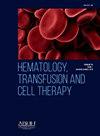DUAL-TRACER PET/CT IMAGING IN HEPATOCELLULAR CARCINOMA: COMPARING THE PERFORMANCE OF 18F-FDG AND 18F-PSMA
IF 1.8
Q3 HEMATOLOGY
引用次数: 0
Abstract
Introduction/Justification
Hepatocellular carcinoma (HCC) is a prevalent malignancy with rising incidence in Western countries, often diagnosed at advanced stages. Early detection and accurate assessment of tumor extent are crucial for optimal treatment planning. 18F-FDG PET/CT has limited diagnostic value in HCC. While prostate-specific membrane antigen (PSMA) is primarily a marker for prostate cancer, its association with tumor neoangiogenesis and demonstrated uptake in various malignancies, including HCC, suggests potential diagnostic applications.
Objectives
This study compared 18F-FDG and 18F-PSMA uptake in PET/CT for evaluating hepatic lesions in HCC.
Materials and Methods
Eleven patients with HCC were included, six with Barcelona Clinic Liver Cancer (BCLC) staging system stage C (advanced) and five with BCLC stage B (intermediate), with a median age of 74 years (range: 59–86). All patients underwent 18F-FDG and 18F-PSMA PET/CT scans with a one-day interval between them. 18F-FDG images were acquired at 60 and 120 minutes post-injection, while 18F-PSMA images were obtained at 90 and 150 minutes. The maximum standardized uptake value (SUVmax) was measured for all hepatic lesions, and the change between early and delayed images (ΔSUVmax) was calculated. Spearman's rank correlation coefficient (ρ) was used to assess the correlation between SUVmax values for the two radiotracers, with statistical significance set at ρ < 0.05.
Results
Nine of the 11 patients had multiple hepatic lesions. A median of 3 lesions per patient (1–15) was detected with 18F-FDG, and 2 lesions per patient (1–11) with 18F-PSMA, totaling 75 lesions. Fifty-six lesions were positive for both radiotracers, 16 were only for 18F-FDG, and 3 only for 18F-PSMA. In the BCLC-B group (n = 5), 11 lesions were detected with 18F-FDG, 15 with 18F-PSMA, and 32 with both. The median SUVmax (early images) was 6.3 (3.5–8.5) for 18F-FDG and 17.2 (15.0–25.6) for 18F-PSMA. In the BCLC-C group (n = 6), 34 lesions were detected with 18F-FDG, 14 with 18F-PSMA, and 24 with both. The median SUVmax (early images) was 8.1 (4.7–17.2) for 18F-FDG and 23.3 (17.1–50.2) for 18F-PSMA. For BCLC-B patients, the median ΔSUVmax was 17.65% (-6.35% to 28.57%) for 18F-FDG and -30.17% (-9.74% to -50.67%) for 18F-PSMA. For BCLC-C patients, the median ΔSUVmax was 0.00% (-66.67% to 10.47%) for 18F-FDG and -0.47% (-67.26% to 16.37%) for 18F-PSMA. Spearman's correlation between 18F-FDG and 18F-PSMA SUVmax was ρ = -0.5357 (ρ = 0.2357).
Conclusion
The 18F-FDG and 18F-PSMA PET/CT provide complementary information for evaluating hepatic lesions in BCLC stage B and C HCC. 18F-FDG detected more lesions, particularly in advanced disease, while 18F-PSMA showed higher uptake, especially in BCLC-C patients. The lack of significant correlation between 18F-FDG and 18F-PSMA SUVmax values suggests they reflect distinct biological processes. This independent uptake pattern may inform treatment strategies. Further research is needed to investigate whether antiangiogenic therapy might be more effective in patients with high 18F-PSMA uptake. The more pronounced 18F-PSMA washout phenomenon observed may have implications for its theranostic potential.
肝细胞癌pet / ct双示踪成像:18f-fdg与18f-psma表现的比较
肝细胞癌(HCC)是一种普遍的恶性肿瘤,在西方国家发病率不断上升,通常在晚期诊断出来。早期发现和准确评估肿瘤范围对优化治疗方案至关重要。18F-FDG PET/CT对HCC的诊断价值有限。虽然前列腺特异性膜抗原(PSMA)主要是前列腺癌的标志物,但它与肿瘤新生血管生成的关联以及在各种恶性肿瘤(包括HCC)中的摄取,提示了潜在的诊断应用。目的:本研究比较了18F-FDG和18F-PSMA在肝癌中PET/CT的摄取情况。材料与方法纳入6例HCC患者,其中6例为巴塞罗那临床肝癌(BCLC)分期系统C期(晚期),5例为BCLC B期(中期),中位年龄为74岁(范围:59-86岁)。所有患者均接受18F-FDG和18F-PSMA PET/CT扫描,扫描间隔一天。在注射后60分钟和120分钟获得18F-FDG图像,在90分钟和150分钟获得18F-PSMA图像。测量所有肝脏病变的最大标准化摄取值(SUVmax),并计算早期和延迟图像之间的变化(ΔSUVmax)。采用Spearman等级相关系数(ρ)评价两种示踪剂SUVmax值的相关性,ρ <具有统计学意义;0.05.结果11例患者中有9例出现多发性肝脏病变。18F-FDG患者平均检测到3个病变(1-15),18F-PSMA患者平均检测到2个病变(1-11),总计75个病变。56个病变两种示踪剂均阳性,16个病变仅检测18F-FDG, 3个病变仅检测18F-PSMA。在BCLC-B组(n = 5)中,18F-FDG检出11例,18F-PSMA检出15例,两者均检出32例。18F-FDG的中位SUVmax(早期图像)为6.3 (3.5-8.5),18F-PSMA的中位SUVmax为17.2(15.0-25.6)。在BCLC-C组(n = 6)中,18F-FDG检出34个病灶,18F-PSMA检出14个病灶,两者均检出24个病灶。18F-FDG的中位SUVmax(早期图像)为8.1 (4.7-17.2),18F-PSMA的中位SUVmax为23.3(17.1-50.2)。对于BCLC-B患者,18F-FDG的中位ΔSUVmax为17.65%(-6.35%至28.57%),18F-PSMA的中位ΔSUVmax为-30.17%(-9.74%至-50.67%)。对于BCLC-C患者,18F-FDG的中位ΔSUVmax为0.00%(-66.67%至10.47%),18F-PSMA的中位ΔSUVmax为-0.47%(-67.26%至16.37%)。18F-FDG与18F-PSMA SUVmax的Spearman相关系数为ρ = -0.5357 (ρ = 0.2357)。结论18F-FDG和18F-PSMA PET/CT对BCLC B期和C期HCC的肝脏病变评估提供了补充信息。18F-FDG检测到更多的病变,特别是在晚期疾病中,而18F-PSMA显示出更高的摄取,特别是在BCLC-C患者中。18F-FDG和18F-PSMA SUVmax值之间缺乏显著相关性,表明它们反映了不同的生物过程。这种独立的摄取模式可以为治疗策略提供信息。抗血管生成治疗是否对高18F-PSMA摄取的患者更有效,还需要进一步的研究。观察到的更明显的18F-PSMA洗脱现象可能对其治疗潜力有影响。
本文章由计算机程序翻译,如有差异,请以英文原文为准。
求助全文
约1分钟内获得全文
求助全文
来源期刊

Hematology, Transfusion and Cell Therapy
Multiple-
CiteScore
2.40
自引率
4.80%
发文量
1419
审稿时长
30 weeks
 求助内容:
求助内容: 应助结果提醒方式:
应助结果提醒方式:


